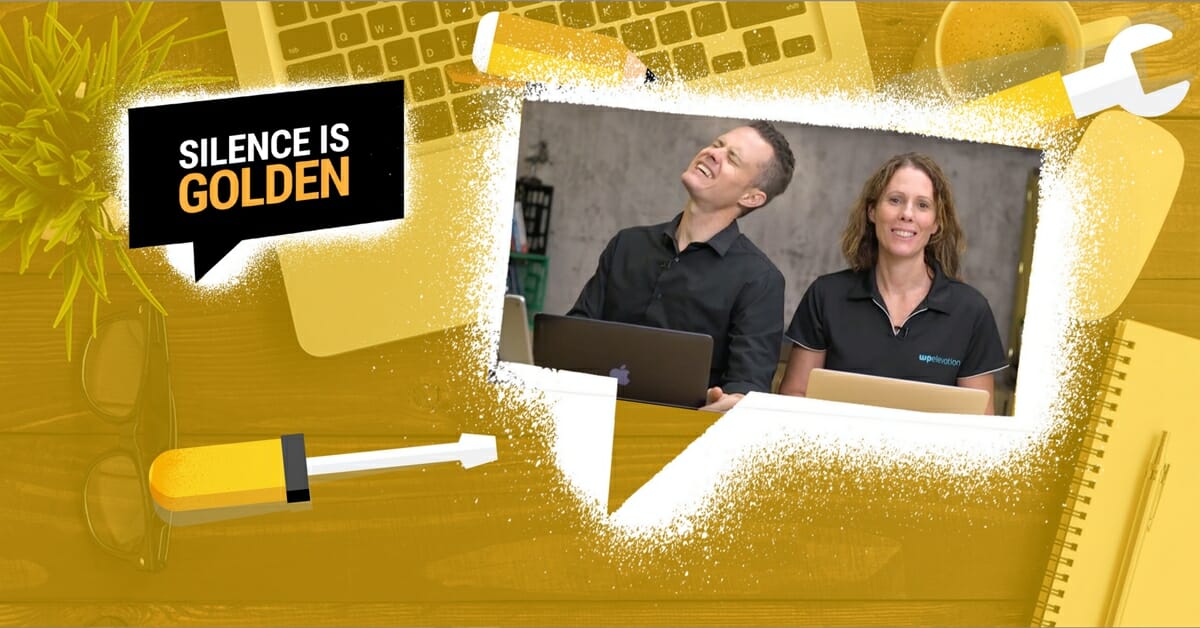Welcome to another episode of Silence is Golden where Troy and Gin (this week) give away invaluable tips for your business.
Today’s main topic is how to stop wasting time and make more revenue by leveraging the system. We also discuss the latest WordPress updates, the 4 most hated UI tricks and we step back in time and have a look at some of the first WordPress websites created from as far back as 1995!
Watch the Video
Stuff That Happened
The WordPress 4.9.5 Release
WPTavern has published an article called Noteworthy Changes Coming in WordPress 4.9.5. However, Troy doesn’t actually think that there is anything noteworthy about it. Apart from the fact that you may need to update PHP to version 7.2. So if you are on a server such as SiteGround, who are on PHP version 5, then you will need to upgrade.
WordPress has also changed the wording on the “Cheatin’ uh?” error message as some people find it a little bit offensive. (We think some people may be a little sensitive.)
Although they didn’t mention it in this article, Troy thinks that one of the most notable changes is the fact that they have introduced a call out to try Gutenberg which will actually be released in version 5.
Hot Tip
If you are trying out Gutenberg, make sure you don't use it on live production, as there are still some issues to iron out.
4 Most Hated UI Tricks
This article from Web Designer Depot talks about the most hated UI tricks that create a bad user experience including Pop-ups. Gin and Troy discuss that they can be annoying but they can also be useful for the business and visitor if the offer and the timing are right. For example, on the WPE website, we make sure that there is no pop-up on the first page and then make sure the pop up is relevant to the page that they’re on. Pop-ups work as long as they’re tasteful.
Infinite scrolling also got a mention in this article. A lot of people don’t like the endless scroll because it can take a while for everything to load and be quite frustrating.
Oh, and push notifications – they’re SO annoying. We would love to hear from anyone that uses them on their site and has been successful.
The article also discusses Scroll Hijacking. This is when the website decides the scrolling behaviour instead of the user. However, check out the Tumblr website to see a good example of what controlled scrolling is. They only use it on the homepage and they actually do it in a tasteful way. If not done well though, this is can very annoying.
The Web Design Museum
The Web Design Museum is an online archive of screenshots from older WordPress sites dating back through 1995-2005+ including the first Coca-Cola website and Google's site from 1998. Check out this article from Hongkiat which showcases some of these websites.
If you want to see one of the first websites that Troy ever built (in 2008!), make sure you watch the show around the 17-minute mark!
This Pisses Me Off
Something is pissing Troy off this week. When people don't leverage the system. He sees people doing the same task over and over again and not getting maximum return on that investment.
How do you leverage the system? Well, for example, very early on in Troy’s career he realised he had to teach people how to use WordPress. It was fun at first, but then he decided he would rather stab himself in the face with a plastic fork than do it again.
He realised that he needed to figure out a way to leverage the system, so he created a 180 page Word document with 85 screenshots to teach people how to use WordPress, then would print it out to give to clients. This evolved to become the Video User Manuals Plugin. (More on that to come).
Troy sees a lot of waste in businesses and lives because people aren’t leveraging the system. So, if you're doing something more than once, how can you delegate it or automate it? Or, if you are being asked the same question frequently, then write a blog post about it, publish it and email it to your clients. You position yourself as the expert by doing this and attract more customers at the same time. Winner, winner, chicken dinner!
Let’s Get Unstuck
This week, Joel Diaz asked Troy how to minimise the risk of taking on a new project and then realising it will take longer than anticipated. How do you reduce the complexity and scope of proposals and how do you make a service more of a product?
The way to do it is by having a look at the commonalities in a particular service. The questions you need to ask yourself are:
- What are the common elements in the projects?
- How do I write very basic documentation to systemise building each of those elements?
- How much are those elements going to cost me to have built by somebody else?
- How do I then price those elements and put them together in a pre-packaged product?
This means that when a client comes to you with a problem, for example, a removal company needing more leads, then you can tell them that you have a product called the “Lead Generation Machine for Removalists”. Now you are selling them a product instead of a bespoke service.
A product is something that you can repeatedly produce to create a predictable result. You can also then train other people how to do it.
Agency Mavericks is a good example of a service which was turned into a product. Troy was coaching and consulting one-on-one over email and telephone so he leveraged the system by recording those lessons as videos and placing them on a website for members. They then hired staff to help deliver the product to customers. This is the same content packaged up as a product where you can serve multiple people at a time.
Time to Dig into the Gold Nugget
The Video User Manuals Plugin was the forerunner to Agency Mavericks. Troy and his partner had this as their side hustle when they were doing consulting work. They collected about 8,500 email addresses from using pop-ups and used that database to launch Agency Mavericks.
This plugin can be used to give your client's WordPress training. So instead of spending a lot of time teaching a client one on one, you can sell this as a product rather than a service.
Key Features:
- There are around 85 video tutorials to teach your clients how to use the back end of WordPress
- It is white labelled completely so you can rebrand the plugin and put your own logo on it
- The videos are available in an American, British and Australian accent
- It teaches the client how to use WordPress as an editor so it doesn't teach them the more complex tasks such as installing plugins or changing the theme
- It teaches the client how to use Yoast SEO, WooCommerce, Google Analytics, Gravity Forms, Beaver Builder and there are more videos to come for popular page builders and Gutenberg
- You can add your own videos
- You get written manuals which can be white labelled as well
- It is automatically updated with every new release
- You can sell it or use it as an added bonus in your sales pitch
Tool of the Week: Free GDPR Webinar
Everyone is going a bit cray-cray over GDPR which is the new European Privacy Regulation. To make your website compliant, it is a tad complex. For example, there is the right to be forgotten. So you need to make sure someone on your list or website can be removed from every part of your database, not just that particular mailout.
Agency Mavericks is partnering with Iubenda to run a free webinar around the 11th April. Iubenda specialises in privacy policies for websites, but you don’t need to use their services, you can do it yourself.
If you want to be notified please leave the comment “GDPR” and we will let you know the details of that webinar.
Wrap Up
Well, that's a wrap for this week. If you like this episode please comment or like, and don't forget to subscribe to our YouTube channel.






